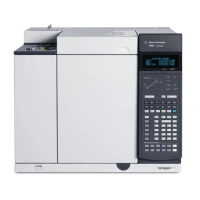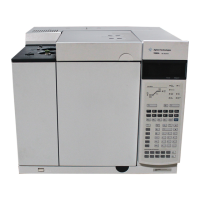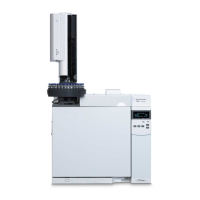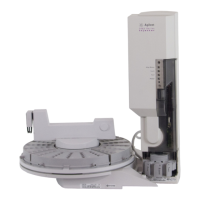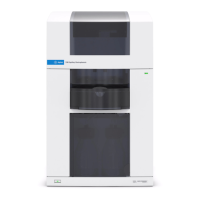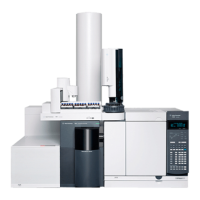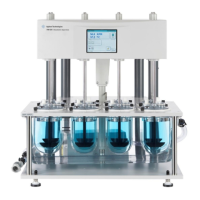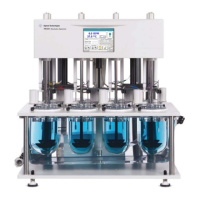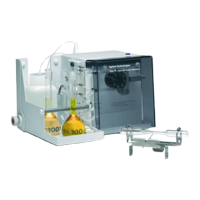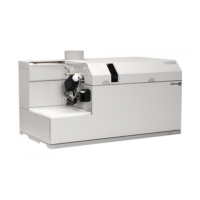Do you have a question about the Agilent Technologies 7890A and is the answer not in the manual?
| Type | Gas Chromatograph |
|---|---|
| Oven Temperature Range | Ambient +4°C to 450°C |
| Maximum Oven Temperature Ramp Rate | 120°C/min |
| Temperature Programming Rates | Up to 120°C/min |
| Injection Modes | Split, Splitless, On-Column, PTV |
| Electronic Pneumatic Control (EPC) | Yes |
| Data System | Agilent OpenLab CDS |
| Injection Ports | Up to 3 |
| Detector Types | FID, TCD, ECD, NPD, MS |
| Inlet Types Supported | Capillary, Packed |
| Communication | LAN, USB |
| Power Requirements | 100-240V, 50/60Hz |
Information regarding Agilent's warranty terms for the document content.
Important hazard warnings, including CAUTION and WARNING definitions.
Guidance on locating additional documentation and resources for the GC.
Explanation of the basic principles of gas chromatography.
Identification of components visible on the front panel of the GC.
Identification of components located on the back of the GC.
Description of the sample injection ports for the GC.
Explanation of the GC column and its temperature-controlled oven.
Details on Agilent's technology for managing gas flow paths.
Overview of the different types of detectors used with the GC.
Description of the GC's control interface, including display and keypad.
General introduction to tasks involved in operating the GC.
Methods for controlling the GC using data systems or the keypad.
Steps for troubleshooting and resolving GC operational faults.
Procedure for powering on and preparing the GC for operation.
Steps for safely powering down the GC for short periods.
Procedure for safely powering down the GC for extended periods.
Instructions for managing methods using the GC keypad.
Instructions for managing sequences using the GC keypad.
Functions of keys used to start, stop, and prepare GC runs.
Accessing maintenance functions, service counters, and diagnostics.
Keys for setting GC parameters like temperature, pressure, and flow.
Displaying current GC status, including ready, not ready, and fault information.
Accessing help and parameter details directly from the GC display.
Keys for entering data, clearing entries, and confirming selections.
Keys for time display, post-run programming, logs, and configuration.
Keys for loading, storing, and managing methods and sequences.
How the keypad operates when the GC is managed by an external data system.
Understanding GC readiness, status lights, and alert tones.
Accessing and understanding run, maintenance, and system event logs.
Guidance on correctly placing sample vials into the sampler turrets.
Procedure for safely setting aside the injector when not in use.
Step-by-step instructions for installing a syringe into the autosampler.
Step-by-step instructions for removing a syringe from the autosampler.
Setting up solvent and waste bottle configurations for the autosampler.
A checklist to ensure the autosampler is ready before running samples.
Instructions for relocating the autosampler to a different GC inlet.
Procedures for configuring the autosampler for cool-on-column injections.
Description of the different turret configurations available for the 7683 ALS.
Instructions for swapping turrets on the 7683 ALS.
Steps for relocating the 7683 ALS to a different GC inlet.
Procedure for safely setting aside the injector when not in use.
Step-by-step instructions for installing a syringe into the 7683 ALS.
Step-by-step instructions for removing a syringe from the 7683 ALS.
Setting up solvent and waste bottle configurations for the 7683 ALS.
Instructions for loading sample vials into the 7683 ALS turret.
Instructions for loading sample vials into the 7683 ALS sample tray.
A checklist to ensure the 7683 ALS is ready before running samples.
Procedures for configuring the 7683 ALS for cool-on-column injections.
Steps for installing a 200-µm column with a cool-on-column inlet.
Procedure for manual sample injection onto a 200-µm column.
Definition and purpose of analytical methods for GC operation.
Details on the parameters and settings stored within a GC method.
Explanation of how loading a method affects the GC's active settings.
Definition and purpose of sequences for automated sample analysis.
Overview of using data systems for analysis and method creation.
